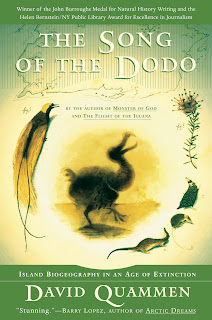I am not sure why I thought the book A World Without Us by Alan
Weisman would be hopeful and cathartic.
(Spoiler: It wasn’t.) Perhaps
because we know humans are the primary driver of climate change and most of the
factors that are causing global extinctions, I naïvely thought removing people
was removing the problem. There is some
comfort in imagining the natural world rebound and recover, even if the price
is loss of a single species dear to our hearts—Homo sapiens. Of course, loss
of humans from the planet would remove *a lot* of problems for the rest of
biodiversity, but what was most surprising to me about this book was how lasting
human impacts will be even if we disappeared instantaneously. While the cities and structures that humans
have built will be short-lived, the contaminants we put into the environment,
in some cases, will be long lasting. Changes in green house gases mean changes
in climate for hundreds to thousands of years.
The consequences of radioactive materials, especially if nuclear
facilities are not shut down properly in a human apocalypse, would be
long-lasting, haunting, and global; however, Weisman points out that Chernobyl
appears largely recovered and that the birds returned immediately as have
people who used to live there (even if its not quite “allowed”). Of course,
presence does not mean safety.
This was an interesting read though, and it does make me
wonder if it would be better to envision a world WITH US, but minimizing our
impacts on the rest of life. Perhaps the
planet could be better WITH US if we could control our impulses, convert to
sustainable energy sources, reduce our global population size voluntarily. Humans clearly have the capacity to build and
structure the part of the environment in which we live, which ripples through
the places where we do not live. If we
put *sustainable living* at the forefront of our design of human spaces, while
reducing population, maybe we could reclaim our place in the natural
world. However, our ability to put
sustainable living at the forefront of anything seems so far-fetched at this
point in time, it is challenging to feel hopeful—which is perhaps why Weisman
didn’t even go there. But, still, I will
(try to) choose hope for a future with a better human consciousness for our
natural world, over hope for our loss.







